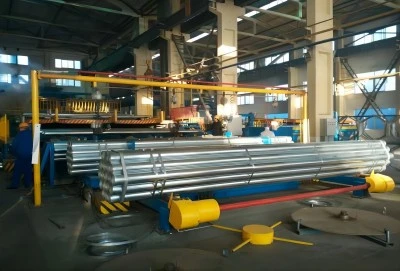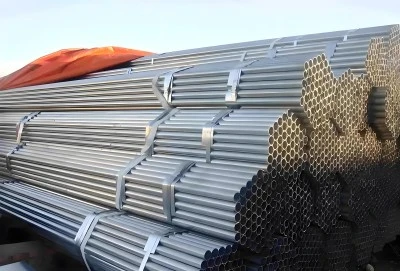Welding galvanized steel pipe requires specialized techniques and precautions due to its zinc coating. The process involves removing the zinc layer, preparing the surface, and using appropriate welding methods to ensure strong, durable connections. For pipeline engineers and project managers in oil and gas, water supply, and industrial manufacturing sectors, mastering galvanized pipe welding is crucial for maintaining structural integrity and corrosion resistance in various applications.
|
|
|
Essential equipment for galvanized steel welding
Protective gear for safe galvanized steel welding
When welding galvanized steel pipes, safety should be your top priority. The zinc coating releases harmful fumes when heated, making proper protective gear essential. Start with a high-quality welding helmet featuring auto-darkening technology to protect your eyes from intense light and sparks. Opt for flame-resistant clothing, including a welding jacket, gloves, and boots to guard against heat and spatter.
Respiratory protection is crucial when working with galvanized materials. Use a NIOSH-approved respirator with the appropriate filters to prevent inhalation of zinc oxide fumes. These fumes can cause metal fume fever, a temporary but unpleasant condition. Don't forget ear protection, as welding processes can be noisy, especially in industrial settings.
Choosing the right welding machine for galvanized pipes
Selecting the appropriate welding machine is critical for achieving high-quality welds on galvanized steel pipes. For most applications, a MIG (Metal Inert Gas) welder is ideal. MIG welding offers good control and can be used with various wire types suitable for galvanized steel. Look for a machine with adjustable voltage and wire feed speed to fine-tune your welding parameters.
Alternatively, TIG (Tungsten Inert Gas) welding can provide excellent results, especially for thin-walled pipes or when appearance is crucial. TIG welding allows for precise heat control but requires more skill and time. For larger diameter pipes or field work, stick welding (SMAW) might be necessary. Ensure your chosen machine can handle the thickness of the pipes you're working with and has the appropriate duty cycle for your project demands.
Specialized tools for handling zinc-coated surfaces
Working with galvanized steel pipes requires some specialized tools to effectively prepare the surface for welding. A heavy-duty angle grinder with various attachments is indispensable. Use wire brush wheels to remove loose zinc without damaging the base metal. Flap discs are excellent for smoothing surfaces and removing stubborn zinc coatings.
Invest in high-quality clamps and pipe stands to secure your workpieces properly. This ensures stability during welding and helps maintain alignment. A digital thermometer or temperature indicator sticks can help monitor heat input, crucial for preventing excessive zinc vaporization. Don't forget about post-weld cleanup tools like chipping hammers and wire brushes to remove slag and restore the protective zinc layer around the weld area.
Step-by-step guide: Preparing galvanized surfaces
Removing zinc coating: Methods and best practices
Effective removal of the zinc coating is crucial for achieving strong, defect-free welds on galvanized steel pipes. The most common method is mechanical removal using an angle grinder with a wire brush or flap disc. Start by marking the area to be welded, extending about 1-2 inches beyond the weld zone on each side. Carefully grind away the zinc coating until you reach the base metal, taking care not to remove too much material.
For more precise removal, especially on thinner pipes, chemical stripping agents designed for galvanized steel can be used. Apply the stripper according to the manufacturer's instructions, then scrape off the loosened zinc. This method is slower but reduces the risk of damaging the pipe. Whichever method you choose, ensure complete removal of the zinc in the weld area to prevent contamination of the weld pool.
Cleaning and degreasing galvanized steel before welding
After removing the zinc coating, thorough cleaning is essential. Use a solvent-based degreaser to remove any oils, dirt, or residues from the surface. Acetone or mineral spirits work well for this purpose. Apply the cleaner with a lint-free cloth, wiping in one direction to avoid spreading contaminants. For stubborn dirt, use a wire brush followed by another solvent wipe.
Ensure the cleaned area extends beyond the weld zone to prevent contaminants from being drawn into the weld pool during the process. Allow the surface to dry completely before welding. Avoid touching the cleaned area with bare hands, as skin oils can contaminate the surface. If necessary, wear clean, lint-free gloves when handling the prepared pipes.
Proper ventilation techniques for galvanized welding
Adequate ventilation is crucial when welding galvanized steel pipes due to the toxic fumes produced. If possible, work outdoors or in a well-ventilated area. For indoor work, use a combination of general and local exhaust ventilation. Set up large fans to create cross-ventilation, directing fumes away from the welding area and the welder.
Local exhaust ventilation, such as fume extractors or welding hoods, should be positioned as close to the weld area as possible without interfering with the welding process. These systems should have a capture velocity of at least 100 feet per minute at the weld point. Regularly check and maintain ventilation equipment to ensure optimal performance. Remember, even with good ventilation, always wear appropriate respiratory protection as an additional safety measure.
Post-welding treatments for optimal results
Applying zinc-rich primers to restore corrosion resistanceAfter welding galvanized steel pipes, it's crucial to restore the corrosion protection lost during the welding process. Zinc-rich primers are an effective solution for this. These primers contain high levels of zinc particles that provide cathodic protection, similar to the original galvanized coating. Before application, ensure the weld area is cool and clean. Remove any slag, spatter, or oxidation with a wire brush or grinder.
Apply the zinc-rich primer according to the manufacturer's instructions, typically using a brush or spray. Ensure even coverage over the weld area and surrounding exposed steel, extending slightly onto the remaining galvanized coating for a seamless transition. Allow the primer to dry completely before handling or exposing the pipe to moisture. For enhanced protection, especially in harsh environments, consider applying a topcoat compatible with the zinc-rich primer.
Cooling and cleaning techniques for galvanized welds
Proper cooling and cleaning of galvanized steel pipe welds are essential for weld integrity and surface preparation for protective coatings. Allow the weld to cool naturally; avoid using water or compressed air, as rapid cooling can lead to weld cracking or distortion. Once cooled, remove any remaining slag using a chipping hammer, being careful not to damage the base metal.
After slag removal, use a stainless steel wire brush to clean the weld and surrounding area thoroughly. This removes oxides and prepares the surface for protective coatings. For a smoother finish, especially if the weld will be visible, consider using a flap disc or fine grit sandpaper. Finally, wipe the area with a solvent cleaner to remove any residual dust or contaminants before applying protective coatings.
Inspecting and testing galvanized steel pipe welds
Thorough inspection and testing of galvanized steel pipe welds are crucial to ensure structural integrity and longevity. Visual inspection is the first step, looking for defects like undercut, overlap, or excessive spatter. Use a magnifying glass for a closer examination of the weld bead and surrounding area. Pay special attention to the transition between the weld and the galvanized coating, checking for any signs of coating damage or separation.
For critical applications, non-destructive testing methods should be employed. Magnetic particle testing can reveal surface and near-surface defects, while ultrasonic testing is effective for detecting internal flaws. In some cases, radiographic testing may be necessary, especially for large diameter pipes or high-pressure applications. For welds that will be under significant stress, consider destructive testing on sample welds to verify strength and ductility. Always follow industry standards and project specifications when conducting weld inspections and tests.
Welding galvanized steel pipes requires careful preparation, proper equipment, and adherence to safety protocols. By following the steps outlined in this guide, pipeline engineers and project managers can ensure high-quality, durable welds that maintain the corrosion-resistant properties of galvanized steel. Remember to prioritize safety, particularly when it comes to fume exposure and proper ventilation. With the right techniques and post-weld treatments, you can achieve reliable connections in your galvanized steel pipe projects, whether for oil and gas transportation, water supply systems, or industrial manufacturing applications. Always stay updated on industry standards and continue to refine your welding skills to meet the evolving demands of global infrastructure projects.
Galvanized Steel Pipes For Sale
Looking for high-quality galvanized steel pipes for your next project? Hebei Longma Group offers premium galvanized steel pipes that meet the highest industry standards. Our state-of-the-art production facilities, equipped with German-imported machinery and four independently developed production lines, ensure consistently superior products. With a team of over 300 skilled employees, including 60+ technical experts, we guarantee top-notch quality and innovation in every pipe we produce.
Our comprehensive testing facilities, featuring online ultrasonic automatic flaw detectors and industrial X-ray television, ensure that every pipe meets stringent quality control standards. We pride ourselves on fast delivery, with standard thickness pipes ready in as little as 7 days. Hebei Longma Group holds all necessary certifications, including API 5L, ISO 9001, ISO 14001, and FPC, demonstrating our commitment to quality and environmental responsibility.
Thanks to our long-term partnerships with raw material suppliers and our integrated production model, we offer competitive pricing without compromising on quality. Whether you need galvanized steel pipes for oil and gas transportation, water supply systems, or industrial applications, Hebei Longma Group has the expertise and capacity to meet your needs. For more information or to place an order, contact us at info@longma-group.com.














